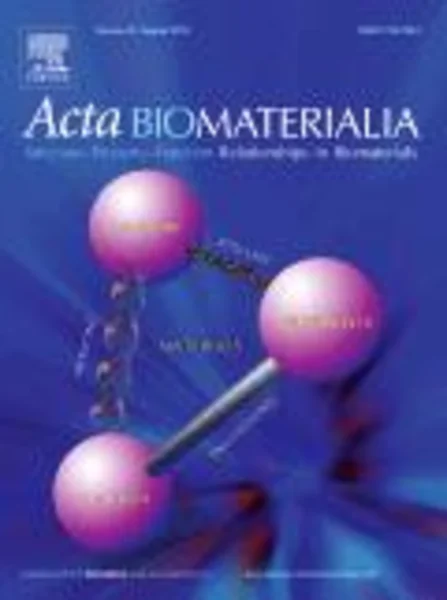-
hydroxyapatite nanoparticle reinforced peptide amphiphile nanomatrix enhances the osteogenic differentiation of mesenchymal stem cells by compositional ratios
جزئیات بیشتر مقاله- تاریخ ارائه: 1392/01/01
- تاریخ انتشار در تی پی بین: 1392/01/01
- تعداد بازدید: 704
- تعداد پرسش و پاسخ ها: 0
- شماره تماس دبیرخانه رویداد: -
in the field of bone tissue engineering, there is a need for materials that mimic the native bone extracellular matrix (ecm). this need is met through the creation of biphasic composites intended to mimic both the organic and inorganic facets of the native bone ecm. however, few studies have created composites with organic ecm analogous components capable of directing cellular behaviors and many are not fabricated in the nanoscale. furthermore, few attempts have been made at investigating how variations of organic and inorganic components affect the osteogenic differentiation of human mesenchymal stem cells (hmscs). to address these issues, biphasic nanomatrix composites consisting of hydroxyapatite nanoparticles (hanps) embedded within peptide amphiphile (pa) nanofibers tailored with the rgds cellular adhesion motif (pa-rgds) were created at various hanp to pa-rgds ratios. fabrication of these biphasic nanomatrix composites was confirmed via scanning electron microscopy (sem) and transmission electron microscopy (tem). the long-term cellularity and osteogenic differentiation of hmscs in response to the different compositional ratios were then assessed by quantifying the timed expression of genes indicative of osteogenic differentiation, alkaline phosphatase activity, and dna content over time. decreased cellularity and the expression of genes over time correlated with increasing compositional ratios between hanp and pa-rgds. the highest hanp to pa-rgds ratio (66% hanp) exhibited the greatest improvement to the osteogenic differentiation of hmscs. overall, these results demonstrate that the compositional ratio of biphasic nanomatrix composites plays an important role in influencing the osteogenic differentiation of hmscs. based on the observations presented within this study, these biphasic nanomatrix composites show promise for future usage in bone tissue engineering applications.
مقالات جدیدترین رویدادها
-
استفاده از تحلیل اهمیت-عملکرد در ارائه الگوی مدیریت خلاقیت سازمانی و ارائه راهکار جهت بهبود
-
بررسی تاثیر ارزش وجوه نقد مازاد بر ساختار سرمایه شرکت های پذیرفته شده در بورس اوراق بهادار تهران
-
بررسی تأثیر سطح افشای ریسک بر قرارداد بدهی شرکت های پذیرفته شده در بورس اوراق بهادار تهران
-
بررسی تأثیر رتبه بندی اعتباری مبتنی بر مدل امتیاز بازار نوظهور بر نقد شوندگی سهام با تأکید بر خصوصی سازی شرکت ها
-
تأثیر آمیخته بازاریابی پوشاک ایرانی بر تصویر ذهنی مشتری پوشاک ایرانی (هاکوپیان)
-
تصویربرداری در دندانپزشکی ایمپلنت، ضرورت استفاده از روش های چند بعدی برای تعیین محل ایمپلنت
-
بررسی پتانسیل نئوپلازی خال سباسه
-
تاثیر بی نظمی در تحلیل دینامیکی فزاینده
-
effect of a vertical fracture on horizontal unsaturated seepage flow
-
effect of nutrition and harvesting time on phenolic compounds and antioxidant properties of peppermint (mentha piperita l.)
مقالات جدیدترین ژورنال ها
-
مدیریت و بررسی افسردگی دانش آموزان دختر مقطع متوسطه دوم در دروان کرونا در شهرستان دزفول
-
مدیریت و بررسی خرد سیاسی در اندیشه ی فردوسی در ادب ایران
-
واکاوی و مدیریت توصیفی قلمدان(جاکلیدی)ضریح در موزه آستان قدس رضوی
-
بررسی تاثیر خلاقیت، دانش و انگیزه کارکنان بر پیشنهادات نوآورانه کارکنان ( مورد مطالعه: هتل های 3 و 4 ستاره استان کرمان)
-
بررسی تاثیر کیفیت سیستم های اطلاعاتی بر تصمیم گیری موفق در شرکتهای تولیدی استان اصفهان (مورد مطالعه: مدیران شرکتهای تولیدی استان اصفهان)
-
اثبات و یأس از اثبات
-
جایگاه کارآموزی در توسعه مهارت الکترونیکی
-
ارائه مدلی یکپارچه از تعریف و ابعاد هویت مکان و تعیین شاخص های سازنده هویت؛ نمونه مورد مطالعه: ساکنین شهر شیراز
-
بررسی اجمالی اثربخشی سازمانی
-
improving equipment reliability and system maintenance and repair efficiency




سوال خود را در مورد این مقاله مطرح نمایید :